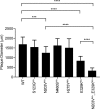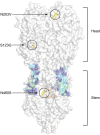Mutations in Influenza A Virus Neuraminidase and Hemagglutinin Confer Resistance against a Broadly Neutralizing Hemagglutinin Stem Antibody
- PMID: 30381484
- PMCID: PMC6321927
- DOI: 10.1128/JVI.01639-18
Mutations in Influenza A Virus Neuraminidase and Hemagglutinin Confer Resistance against a Broadly Neutralizing Hemagglutinin Stem Antibody
Abstract
Influenza A virus (IAV), a major cause of human morbidity and mortality, continuously evolves in response to selective pressures. Stem-directed, broadly neutralizing antibodies (sBnAbs) targeting the influenza virus hemagglutinin (HA) are a promising therapeutic strategy, but neutralization escape mutants can develop. We used an integrated approach combining viral passaging, deep sequencing, and protein structural analyses to define escape mutations and mechanisms of neutralization escape in vitro for the F10 sBnAb. IAV was propagated with escalating concentrations of F10 over serial passages in cultured cells to select for escape mutations. Viral sequence analysis revealed three mutations in HA and one in neuraminidase (NA). Introduction of these specific mutations into IAV through reverse genetics confirmed their roles in resistance to F10. Structural analyses revealed that the selected HA mutations (S123G, N460S, and N203V) are away from the F10 epitope but may indirectly impact influenza virus receptor binding, endosomal fusion, or budding. The NA mutation E329K, which was previously identified to be associated with antibody escape, affects the active site of NA, highlighting the importance of the balance between HA and NA function for viral survival. Thus, whole-genome population sequencing enables the identification of viral resistance mutations responding to antibody-induced selective pressure.IMPORTANCE Influenza A virus is a public health threat for which currently available vaccines are not always effective. Broadly neutralizing antibodies that bind to the highly conserved stem region of the influenza virus hemagglutinin (HA) can neutralize many influenza virus strains. To understand how influenza virus can become resistant or escape such antibodies, we propagated influenza A virus in vitro with escalating concentrations of antibody and analyzed viral populations by whole-genome sequencing. We identified HA mutations near and distal to the antibody binding epitope that conferred resistance to antibody neutralization. Additionally, we identified a neuraminidase (NA) mutation that allowed the virus to grow in the presence of high concentrations of the antibody. Virus carrying dual mutations in HA and NA also grew under high antibody concentrations. We show that NA mutations mediate the escape of neutralization by antibodies against HA, highlighting the importance of a balance between HA and NA for optimal virus function.
Keywords: broadly neutralizing antibody; hemagglutinin; influenza virus; mutants; neuraminidase; resistance.
Copyright © 2019 American Society for Microbiology.
Figures









References
-
- Palese P, Shaw M. 2007. Orthomyxoviridae: the viruses and their replication, p 1647–1690. In Knipe DM, Howley PM, Griffin DE, Lamb RA, Martin MA, Roizman B, Straus SE (ed), Fields virology, 5th ed Lippincott Williams & Wilkins, Philadelphia, PA.
-
- White J, Hoffman L, Arevalo J, Wilson I. 1997. Attachment and entry of influenza virus into host cells. Pivotal roles of hemagglutinin, p 80–104. In Chiu W, Burnett RM, Garcea RL (ed), Structural biology of viruses, Oxford University Press, Oxford, United Kingdom.
Publication types
MeSH terms
Substances
LinkOut - more resources
Full Text Sources
Other Literature Sources
Miscellaneous

